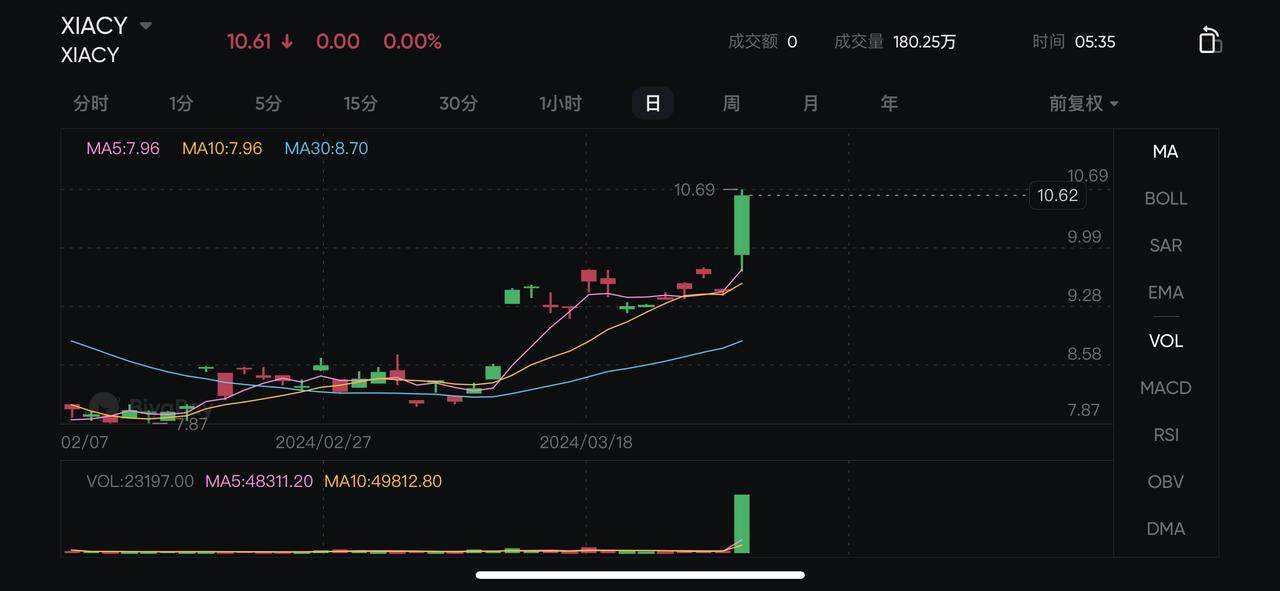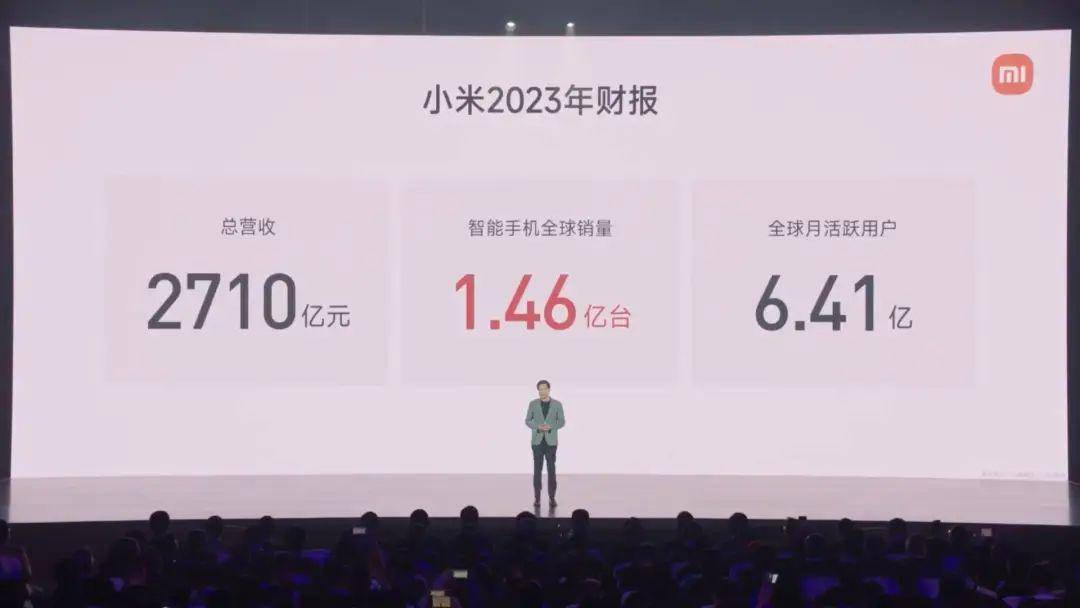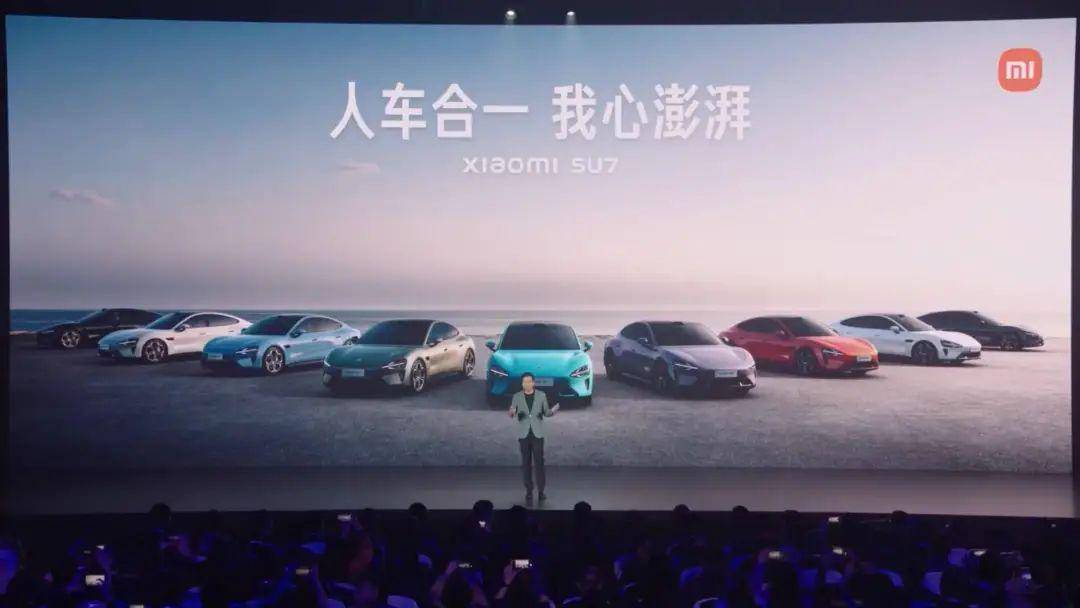- Remittance
- Exchange Rate
- Stock
- Events
- EasyCard
- More
- Download
Why Did Apple Not Succeed in Making Cars While Xiaomi Did?
On the evening of March 28th, Xiaomi’s automobile SU7 was officially launched for sale, starting at a price of 215,900 yuan. The announcement of the price immediately caused a frenzy on the internet, with hot search topics related to Xiaomi cars almost dominating the charts. According to Xiaomi’s official Weibo, within 27 minutes of the launch, 50,000 units were ordered.
As a result of this event, Xiaomi’s ADR (XIACY) on the US stock market surged, with the stock price at one point increasing by 15%. By the close of Thursday, Xiaomi’s ADR (XIACY) had risen by over 12%. At the time of writing, according to the multi-asset trading wallet BiyaPay, Xiaomi’s ADR (XIACY) was quoted at $10.61.

However, in stark contrast to Xiaomi, Apple, also a smartphone company, gave up on making cars.
The Development Path of Smartphone Manufacturers
Between 2020 and 2024, it was seen as an inevitable development path for smartphone manufacturers to venture into car making, with rumors and facts emerging together.
However, by 2024, OV denied car-making rumors, Apple gave up on making cars, and Huawei decided not to make cars but to enable car-making, Lei Jun suddenly realized that on the path of making both smartphones and cars, he had become a lone brave.

At the Xiaomi SU7 launch event, founders of three companies, including Weilai, attended to watch Xiaomi, which is both similar and dissimilar to Apple in the context of smartphone manufacturers’ trend towards car making. This trend was indeed the natural choice for business extension for smartphone companies before the consensus broke down.
We can summarize the business expansion path of smartphone manufacturers as follows:
From 2007, when the iPhone was launched, to around 2016, when the shipment of smartphones peaked, during these nearly 10 years, smartphones developed rapidly, with the main focus and revenue of manufacturers concentrated on the smartphone business.
In early 2010, the first generation iPad was released, and tablets became an important revenue supplement for many manufacturers beyond the smartphone business.
By 2014, the concept of wearable devices became very popular, with the first Xiaomi Mi Band being a blockbuster product; the following year, the Apple Watch was released, becoming a must-have for Apple fans. These innovative devices became another wing of revenue for smartphone manufacturers.
Then, in 2016, as the smartphone market saturated and entered a phase of stock competition, traditional PC businesses became a new choice for Xiaomi and Huawei to expand their revenue scope, with Apple being an exception as it started with computers.
In the same year, the release of Apple AirPods, true wireless headphones, contributed to the business growth of smartphone manufacturers. During this process, the concept of “smart home” and “IoT” began to take shape, with TVs, smart speakers, routers, and other hardware considered the “smart hub” being transformed by smartphone manufacturers.
There are mainly three ways for smartphone manufacturers to sustain growth:
1.Growth of the smartphone business itself: grow with the market, go overseas when the market saturates, and raise prices when everything is saturated.
2.Category innovation, creating new markets: such as tablets, watches, bracelets, wireless headphones, and less successful attempts like VR, drones, and robots.
3.Entering red oceans, seizing old markets: such as computers, TVs, refrigerators, washers, air conditioners, and other home appliances.
After 2020, a severe problem was discovered: the new categories stopped innovating, and the old markets had little potential for transformation.
Why Did Xiaomi and Apple Decide to Make Cars?
Thus, to continue growing, Xiaomi took two steps: high-end transformation of Xiaomi phones and the Xiaomi brand, and car-making.
The recently released Xiaomi financial report for 2023 provides insight into many issues. Last year, Xiaomi’s total revenue was 271 billion yuan, lower than the 280 billion yuan in 2022 and 3283 billion yuan in 2021, indicating that Xiaomi’s existing business could no longer support continuous revenue growth. However, the good news is that Xiaomi’s net profit in 2023 increased by 126.3% to 19.3 billion yuan, especially in the fourth quarter, when Xiaomi’s revenue reached a new high of 73.2 billion yuan over seven quarters, with adjusted net profit increasing by 236.1% to 4.9 billion yuan. Additionally, by the end of 2023, Xiaomi’s cash reserves amounted to 136.3 billion yuan, indicating that previous investments in the automobile business did not drag down performance, and Xiaomi could continue investing in new business without external investors.

A look at Apple’s financial report reveals a very similar situation.
In the fiscal year 2023 (from September 24, 2022, to September 30, 2023), Apple’s revenue was 383.2 billion dollars, slightly lower than the 394.3 billion dollars in fiscal year 2022, with a slight decrease in profits. Apple also has a massive cash reserve of 162 billion dollars. The business composition is similar: income from phones accounts for 50% to 60%; other hardware accounts for 25% to 30%, with decent internet and software income as a continuous supplement. As long as one is in the smartphone and its ecosystem, limited by the industry’s slowing demand and longer replacement cycles, it is almost impossible to achieve significant growth in shipments. The most effective way to preserve revenue now is to increase the average selling price.
In 2023, the average selling price of Xiaomi phones in China increased by 19%, demonstrating the upward trend of Xiaomi phones and the inevitable choice of mainstream smartphone manufacturers as overall shipments declined. Xiaomi President Lu Weibing also stated that in 2024, Xiaomi phones must break through the price range of 6000 to 10,000 yuan. Apple is in a similar situation; three years ago, the average selling price of an Apple phone was over 860 dollars, now approaching 1000 dollars. Data from Counterpoint Research shows that the total revenue of the global smartphone market in 2023 was 410 billion dollars (about 2948.9 billion yuan), with Apple accounting for nearly 50% of the revenue and 90% of the profit, marking a 2% year-on-year decrease.
Thus, Xiaomi and Apple’s contemplation of car-making appears more as a natural choice based on their own situations.
Compared to the approximately 400 billion dollar smartphone market each year, the automobile industry is larger and broader, with more players and categories, and is currently undergoing a century-long transformation, making it the largest single category market outside of real estate. Cars are not like smartwatches and wireless headphones, which are newly emerging categories; they are a mature market that has existed for over a hundred years. Cars are also not like TVs and computers, categories with fixed forms and limited innovation scope. The current transformation in intelligent cockpit networking, power electrification, and driving automation is making the automobile industry more seamlessly connected to the consumer electronics industry before.
In general, the context for Xiaomi and Apple to consider car-making is not much different: the main business is hard to grow, there is a large amount of cash on hand, and the drastic changes in the automotive market offer the greatest possibility. Of course, many differences can be pointed out between the two companies, such as Apple’s more closed system ecosystem, Xiaomi being more open; Apple earns more elegantly through the App Store toll model compared to Xiaomi’s ad revenue; Xiaomi and Mi Home’s IoT product categories far exceed Apple’s hardware categories, and so on.
But the real key difference in car-making led to the diverging paths of the two companies.

Xiaomi is more like a manufacturing company, but Apple is not
Ten years ago, in 2014, Xiaomi completed its fifth round of financing with a valuation of 40 billion dollars, and that year, Xiaomi’s revenue was about 70 billion yuan. Now, Xiaomi’s market value in dollars is approximately 48.5 billion, with last year’s revenue at 275 billion yuan. Over these ten years, Xiaomi’s revenue and profits have continuously grown, but Xiaomi’s market value has not increased much compared to the valuation at that time. What happened? If one remembers Xiaomi in 2014, one word would come to mind: “Internet thinking.” When Xiaomi’s annual revenue was 70 billion yuan, it achieved a 40 billion dollar valuation because investors regarded Xiaomi as a “mobile Internet company.” Ten years ago, this was the most attractive sector, and companies in this sector, like Tencent and Alibaba, could get much higher price-earnings ratios or price-to-book ratios for valuation than traditional industries. However, when Xiaomi officially went public in 2018, investors valued Xiaomi as a manufacturing company rather than an Internet company.
Now, the mobile Internet is no longer attractive, and companies like Tencent and Alibaba are undervalued. The AI sector, represented by companies like Nvidia, which recently reached a market value of 2 trillion dollars, is now attractive. At this point, Xiaomi no longer mentions the term “Internet thinking.” As for the automotive industry, except for Tesla and BYD, which represent trends, and a few brands like Ferrari that only make ultra-luxury cars, it is generally a sector with low price-to-earnings ratios and profit margins because the automotive industry is indeed a manufacturing industry. Even Porsche, which only makes luxury cars, has a recent net profit margin of around 15%, far less than Apple’s net profit margin of about 26%, while other car companies like BMW, Tesla, and Toyota have net profit margins generally in the single digits.
When manufacturing, low net profit margins, and low price-to-earnings ratios come together, along with trends of intelligence and connectivity, Lei Jun, looking at the financial report’s single-digit net profit margin (7.1% in 2023), donned a Xiaomi car uniform and used Xiaomi 14 Ultra’s HyperOS, feeling a sense of mission to make heartwarming products at reasonable prices, including cars.But Apple is different. Looking at Apple’s financial report with a gross margin of about 45% and net profit margin, and comparing it with luxury car brands like Porsche, BMW, and Mercedes-Benz, the difference is clear. The automobile industry is a century-old industry where the investment amount, costs, selling price, profits, and behind-the-scenes profit margins and return on investment are relatively predictable. Apple cannot redefine the automobile market as it did with smartphones, then leverage a trillion-dollar industry to sell millions of cars annually at 100,000 dollars each, making tens of thousands of dollars in profit per car.Apple cannot create the “high selling price, high profit margin, and high market share” impossible triangle for cars, and even car manufacturers who achieve two out of these three are extremely rare, but Apple has indeed achieved such an impossible triangle in the smartphone industry. Compared to that, Xiaomi is not interested in such extreme business models and is not good at them, even actively embracing low profit margins, promising not to engage in high hardware profit rates.
This is the real logic behind Xiaomi’s success in car-making and Apple’s decision to give up.
So, when Xiaomi’s car was launched, Xiaomi’s ADR (XIACY) on the US stock market soared.
How should ordinary investors invest in Xiaomi?
Within 27 minutes of the launch of Xiaomi SU7, the order volume exceeded 50,000 units. This strong market performance propelled Xiaomi Group’s ADR to close at 10.619 USD/share on the US stock market. Moreover, Xiaomi Group’s strong performance also drove attention and capital inflow to related Exchange Traded Funds (ETFs), such as the China Internet ETF (513220) and the Hong Kong Tech 50 ETF (159750), which continued to trade at a premium during the trading session. The China Internet ETF tracks the securities of the 30 largest mainland Chinese companies listed globally in the internet sector, while the Hong Kong Tech 50 ETF focuses on the 50 leading tech stocks in Hong Kong.
If investors want to catch this rise, it is recommended to regularly monitor the market trends on the BiyaPay App and enter the market at the right time. To buy at a lower price, simply search for its code on BiyaPay to trade online in real-time. Investors can also deposit digital currency (USDT) into BiyaPay, then withdraw fiat currency to invest in Xiaomi’s ADR or other Chinese concept stocks at other brokers.
Conclusion: The Future of Xiaomi and Apple
From Xiaomi’s corporate perspective, automobiles are the most suitable field for Xiaomi’s development. From Lei Jun’s personal perspective, choosing the geographically stronger automobile sector, which has a natural appeal to entrepreneurs and business leaders as a new meta-narrative theme, is the right choice. Apple, on the other hand, made the absolutely correct strategic decision to focus on artificial intelligence, with the timing also being appropriate. The three necessary conditions for success in artificial intelligence are talent, data, and computing power, which are Apple’s strengths.

























